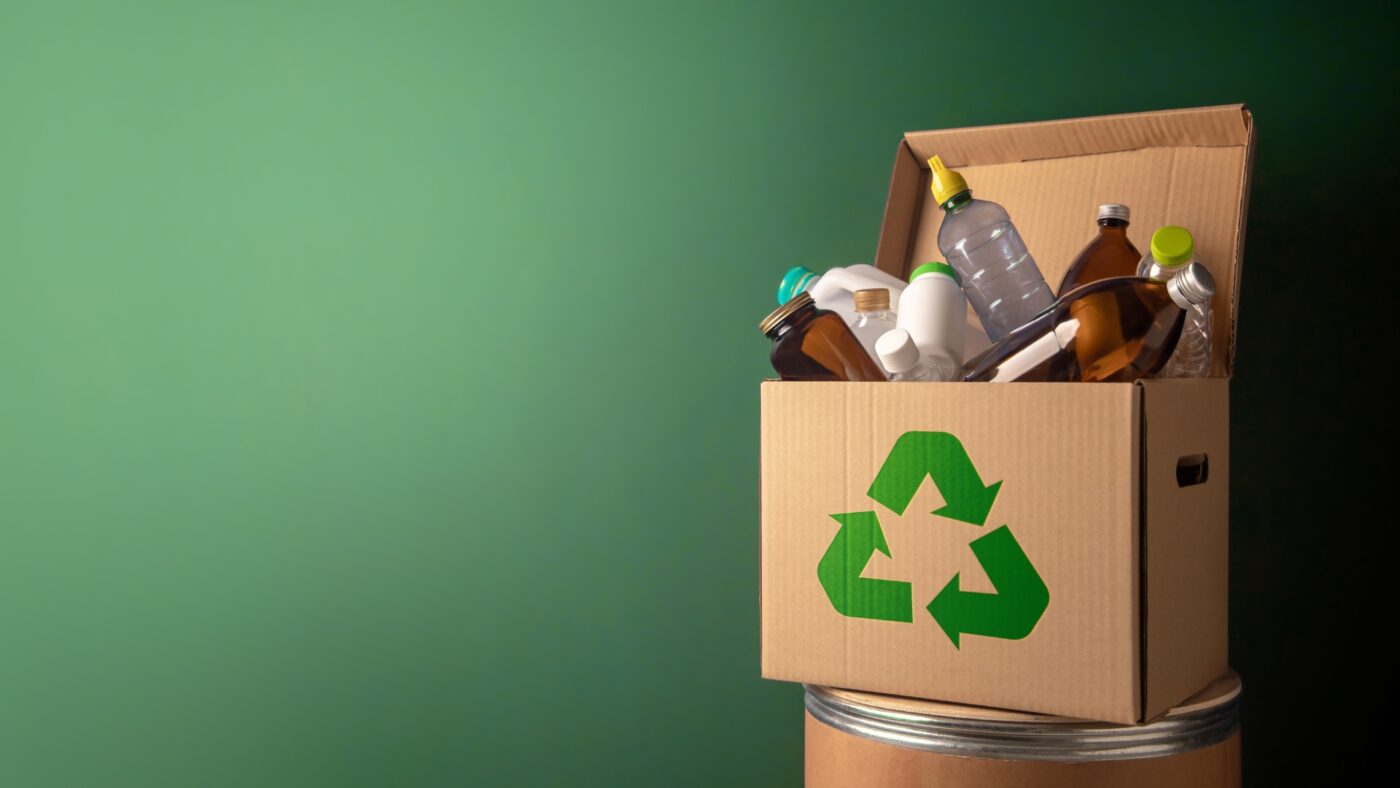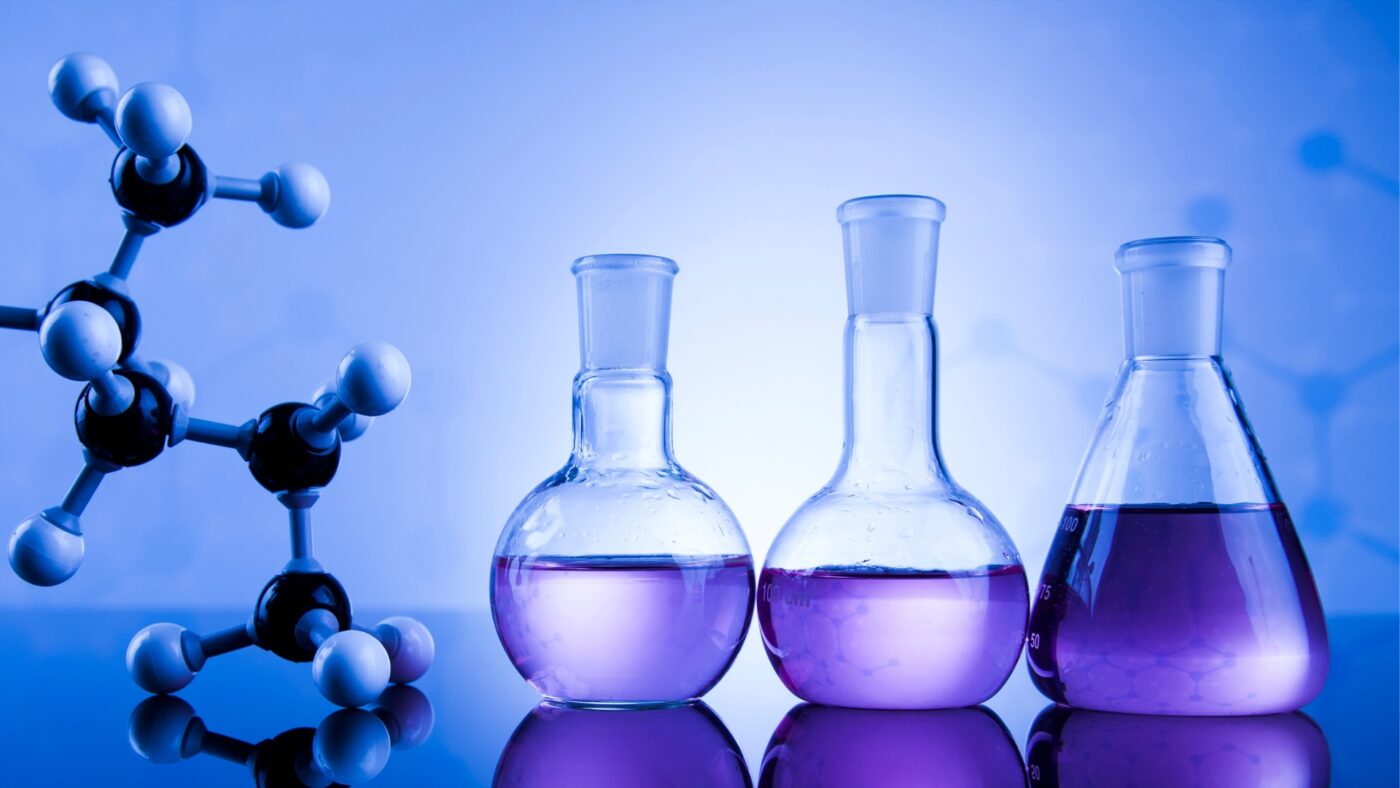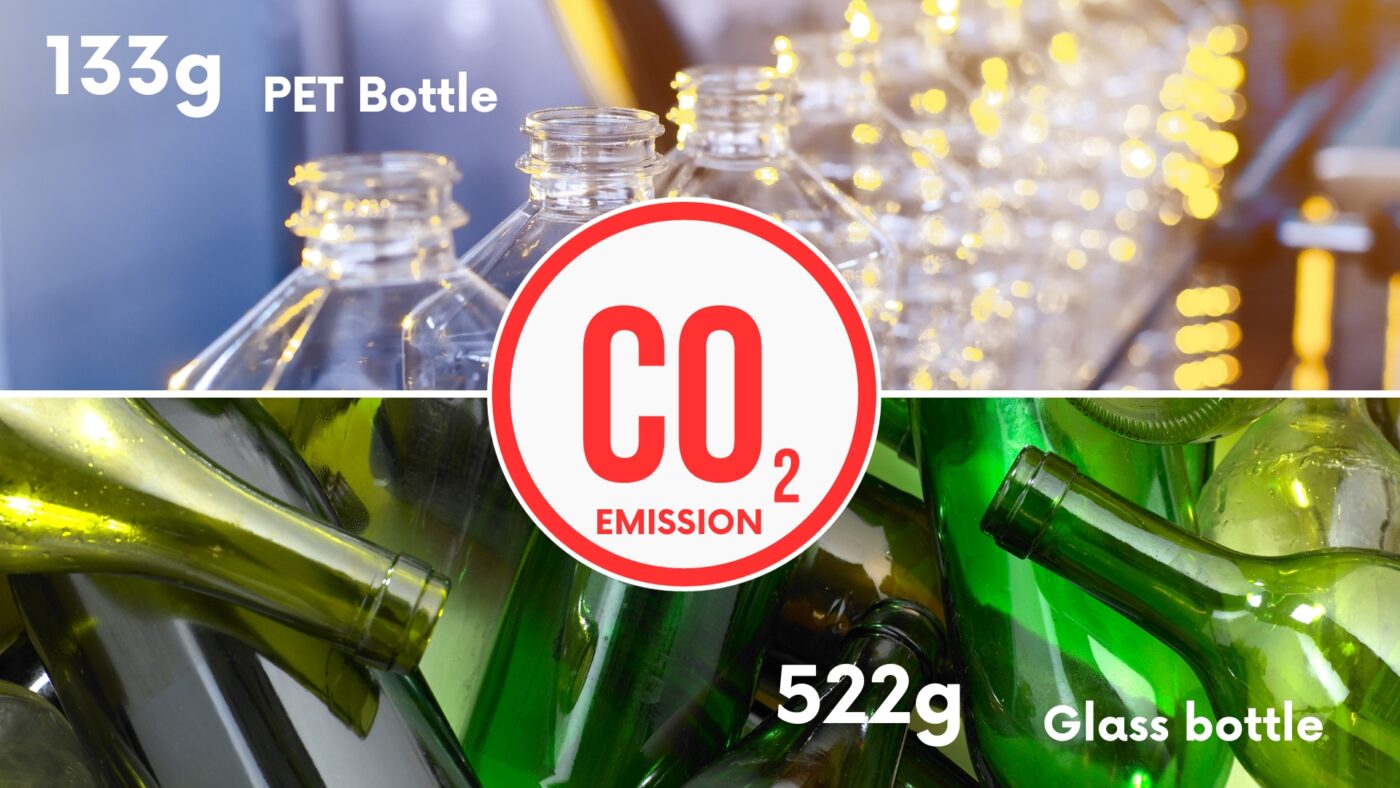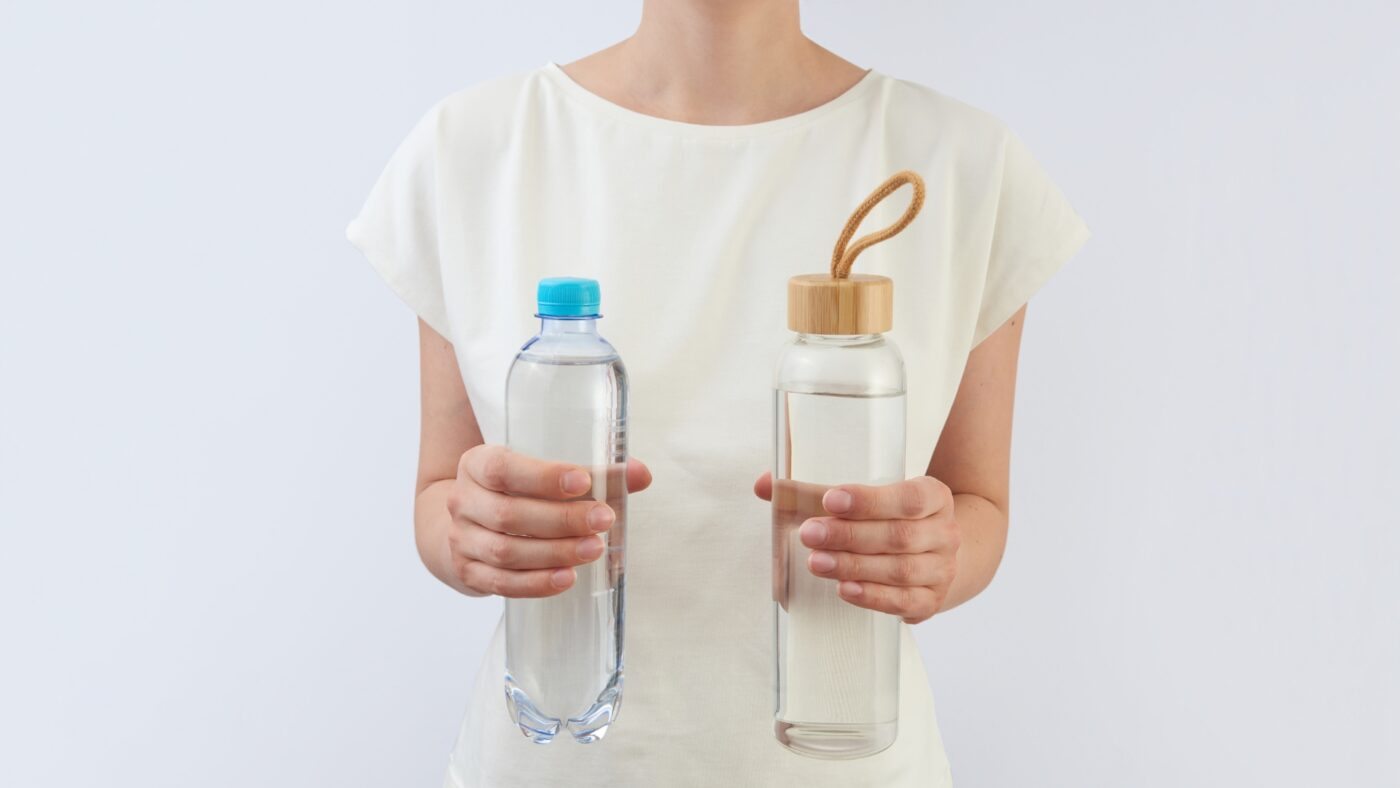One of the most frequently used packaging in everyday life are bottles. They can be used to store water and other liquid food products, but also cosmetics and cleaning products. The traditional material for the production of bottles is glass – a material with a very long history, but in recent years, in many applications, it has been replaced by plastics, most often by polyethylene terephthalate, abbreviated as “PET”, as well as materials from the polyolefin group, such as high-density polyethylene ( PE-HD) or polypropylene (PP), less often by other materials, such as polycarbonate (PC).
Traditional materials vs. modern plastics
The spread of plastics in the packaging industry has a practical justification. Plastic bottles are lighter than their glass counterparts for two reasons: the first is the density of the material and the second is the possibility of producing a thin-walled product from plastic that will not be easily destroyed. The density of glass is 2.5 g/cm3, which is approximately twice the density of plastics. For example, the density of PE-HD and PP plastics is 0.95 and 0.90 g/cm3, respectively (average values), and PET plastics: about 1.4 g/cm3. In addition, a plastic bottle may have a much thinner wall. Plastics for packaging, especially PET, used primarily for water and beverage bottles, are not easily damaged. In turn, the fragility of glass makes it necessary to produce packaging with a thicker wall, which results in an even greater bottle weight. For example, the weight of a 0.5 liter PET bottle is less than 20 g, while a glass bottle of the same capacity weighs approximately 300 g. The weight of a 1 liter bottle is approximately 25 g (plastic) and approximately 470 g, respectively. (glass) [1,2]. PET, thanks to its durability properties, can be used to produce a thin-walled bottle for single use (with the possibility of further recycling), but also a bottle with a thicker wall, crush-resistant, for repeated use. The improvement of the properties of materials that has occurred over the last few decades is also important. The development of materials has resulted in the strength of the PET plastic used today being greater than several dozen years ago, which allows the production of bottles with thinner walls than before, while maintaining the strength of the product. The low weight of plastic bottles is both convenient for the user who likes to pack a light bottle into a backpack, but also reduces the costs of transporting products to stores. The risk of damage to glass bottles during transport is a factor limiting the use of glass bottles.
Recycling – glass vs. plastics

What is a disadvantage in one aspect may become an advantage in another. The fragility of glass favors its recycling because it makes it easier to obtain glass cullet, which is added to the production of new products. In the case of plastics, waste shredding is also possible, but requires the use of special machines or production lines. Both materials – glass and plastic – must be cleaned before being recycled, as even small amounts of contaminants may disturb the process of producing new products and disqualify them from being placed on the market. Plastic waste can be used to obtain raw material for reprocessing, either in the form of regranulate or, as is the case with PET, in the form of the so-called petals. Such a raw material can be recycled as long as it is a thermoplastic, but plastics commonly used to produce bottles meet this condition. In the designations of recycled material, the letter “r” is added, hence the designation rPET. Recycled raw material (if it is of appropriate purity) can even be partially used to produce new beverage bottles, and if it is not of appropriate purity, it can be used to produce other everyday products. Thanks to its fiber-forming properties, it is possible to obtain fiber from PET material, which is used for the production of clothes, fillings for toys such as mascots, quilts, etc. It is also possible to produce transparent foil for packaging tools, computer equipment and other products.
Chemical resistance of packaging

Chemical resistance is a desirable feature of packaging. Excellent chemical resistance is an undoubted advantage of glass. In the case of PE-HD and PP plastics, their high chemical resistance makes them suitable for packaging for cleaning products. Additionally, plastics processing makes it possible to produce multi-layer products, of which one layer, made of a different material, will act as the so-called a “barrier” protecting stored substances from access, e.g., oxygen. However, products consisting of layers of several different materials are not preferred in recycling, where the most desirable case is a homogeneous material.
Dyeing is also possible with both materials. White glass can be used for water bottles, but it can also be obtained from brown glass (so-called amber glass) to protect the contents of the bottle against UV rays, or green glass, or other colors of glass, by selecting the appropriate set of ingredients when melting the glass mass. Obtaining a wide range of colors is an indisputable advantage of plastics. PET is highly transparent, but it is also possible to produce opaque bottles of various colors from this material, as is the case, for example, with ketchup bottles. PE-HD or PP plastics can be colored very easily, using special coloring additives, to obtain a variety of colors, with even subtle differences, which is welcome, especially in the case of packaging for cosmetic products. Generally, in the case of plastics, it is possible to modify their properties, including colors.
Energy consumption of production and impact on the environment.
In the era of searching for energy savings and reducing heat emissions, the energy consumption of production cannot be overestimated. In the production of glass products, the temperature in the furnace for melting the ingredients and obtaining the glass mass exceeds even 1500 ° C and it is a very energy-intensive process. Blowing a plastic bottle requires processing the granulate at a temperature of approximately 200°C (polyolefin blowing) and producing a PET semi-finished product, the so-called preform, takes place at a temperature of approximately 280°C. We must also remember about the process of producing the raw material itself – plastic granulate, which also requires increased temperature and pressure in plants processing, among others, refined petroleum products. Glass, on the other hand, is produced from mineral raw materials. Reducing the use of fossil fuels is one of the incentives to recycle plastics.

The trend towards reducing and calculating CO2 emissions for various activities in industrial production, agriculture and other aspects of life is also visible in comparisons of different packaging material options. The energy used in the glass production process corresponds to the emission of 3.0 g of CO2 per 1 g of glass, with a value of 3.8 g of CO2 per 1 g of plastic during its production and processing [3]. In this comparison, however, plastics have an advantage because they have a lower packaging weight, as 1 kg of plastic can produce more bottles than 1 kg of glass. The results of life cycle analysis (LCA – Life Cycle Assessment), covering, in addition to production and bottle filling, also (among others) transport and recycling, are rather favorable for plastics, although much depends on the case being compared. If we assume that the bottle is to be single-use, then for a 1-liter mineral water bottle, the CO2 emission (CO2 emission equivalent index to the environment) for a glass bottle is estimated at 522 g of CO2, while for a PET bottle this value is four times lower: 133 g CO2 [2]. However, these values can be comparable when a returnable glass bottle (reusable) and a disposable PET bottle are taken into account: in the study [4] the following values were calculated: 190.5 g of CO2 for a glass bottle and 188.5 g of CO2 for a bottle with PET. It should be remembered that the values obtained in LCA analyzes may differ because they depend on many factors, such as the transport route during the distribution of bottled water and even whether the water is carbonated (this requires a larger wall thickness of the PET bottle), or not [4]. The CO2 emission equivalent index for one PET bottle is lower when recycled plastic (rPET) is added during production and, of course, the lower the higher the content of recycled plastic in the bottle material [5÷7], but also the higher the efficiency of the system collecting bottles [7]. This is another argument for waste segregation and reuse of materials.
Plastic packaging is often perceived as potential garbage. This is caused, among other things, by the fact that plastic bottles float on water due to the low density of plastics, lower or similar to the density of water. Glass or metal objects usually sink in a body of water and remain invisible at first glance, although they still litter the environment. Taking care of the cleanliness of the environment and sending packaging for recycling is primarily the role and responsibility of consumers. Throwing a glass or plastic bottle into an appropriate container (yellow) increases the chance of the bottle being reused without major contamination. It is therefore worth making some effort to avoid becoming the “end user” of the bottle. There is still a need to improve recycling efficiency. Perhaps some more water will flow in the rivers before the ambitious goals set for the societies of countries, especially European ones, are achieved. I hope there are no bottles in this water.
Literature
1. Facts and myths about plastic packaging. Republic. 27/08/2020: https://www.rp.pl/wydarzenia/art556591-fakty-i-mity-o-opaczeniach-z-powiedzw
2. https://sozosfera.pl/srodowisko-i-gospodarka/twarza-sztne-i-mjsze-emisje-co2/ (2021)
3. Moczyńska H.: Glass packaging and plastic packaging – lower cost and better durability. The World of the Pharmaceutical Industry. 14/01/2021: https://przemyslfarmaceutyczny.pl/artykul/opakowania-szklane-a-opakowania-plastikowe-nizszy-koszt-i-lepsza-trwalosc
4. Ferrara C., De Feo G., Picone V.: LCA of Glass Versus PET Mineral Water Bottles: An Italian Case Study, Recycling 2021 https://www.mdpi.com/2313-4321/6/3/50
5. Amienyo D., Gujba H., Stichnothe H., Azapagic A.: Liffe cycle environment al impacts of carbonated soft drinks, Int. J. Life Cycle Assess. 18, 77-92 (2013): https://link.springer.com/article/10.1007/s11367-012-0459-y
6. Radaal H.L., Iversen O.M.K., Modahl I.S.: LCA of beverage container production, collection and treatment systems, Ostfoldforskning commissioned by Infinitum AS, Sep. 2016: https://norsus.no/wp-content/uploads/or-14-16_v10-lca-beverage-containers.pdf
7. Stefanini R., Borghesi G., Ronzano A., Vignali G. Plastic or glass: a new environmental assessment with a marine litter indicator for the comparison of pasteurized milk bottlers, Int. J. Life Cycle Assess. 26, 767-784 (2021): https://link.springer.com/article/10.1007/s11367-020-01804-x
August 17, 2023
dr inż. Tomasz Jaruga

